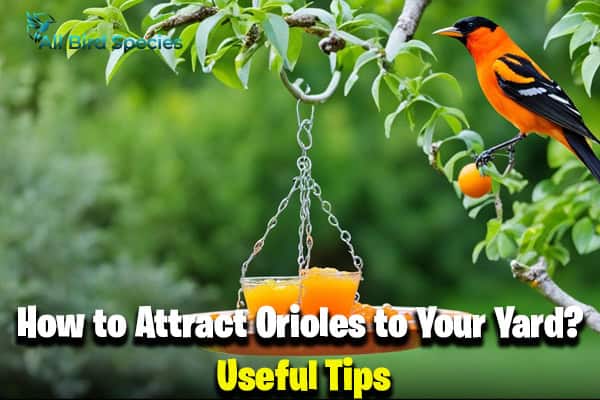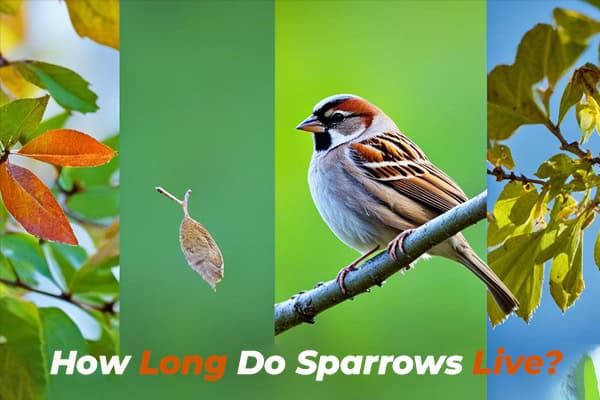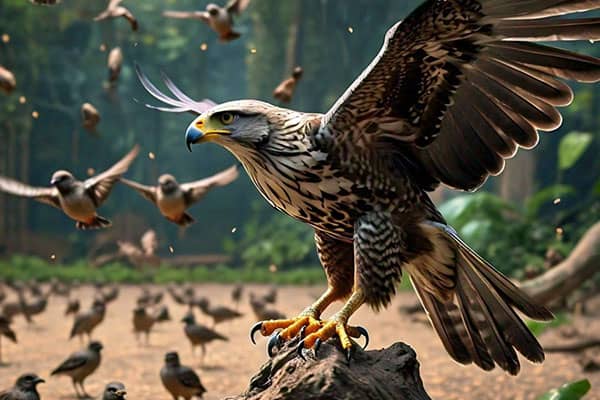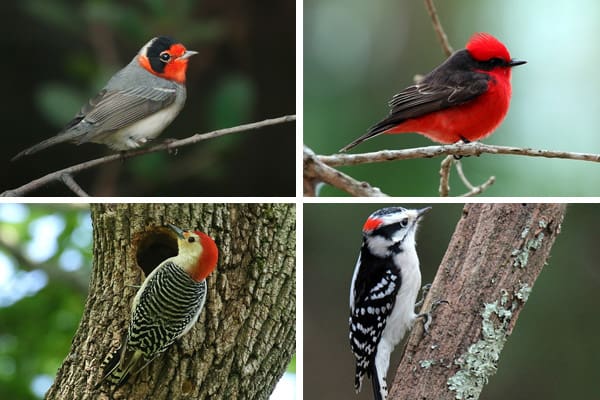How to Attract Orioles to Your Yard? Useful Tips
Did you know nearly 85% of backyard birdwatchers want to attract orioles? These birds are known for their bright orange and black or yellow feathers. They add color and charm to their songs. But, orioles can be hard to spot because they are shy.
By knowing what orioles need, like food, water, and shelter, you can attract them. This will turn your yard into a place where these birds love to be. Let’s explore some great tips on how to feed orioles and make your yard a haven for them.
~Here we’ll learn about How to Attract Orioles to Your Yard~
Understanding Orioles: Species and Habitats
Exploring different oriole species helps us learn about their homes. The United States has many oriole types, each with its own colors and ways of living. The Baltimore oriole is a well-known bird that lives in the east. It’s easy to spot because of its bright colors as it moves through the trees.
Other orioles include the Bullock’s, Orchard, Hooded, and Scott’s orioles. Each one has its own special place to live and things it needs to survive.
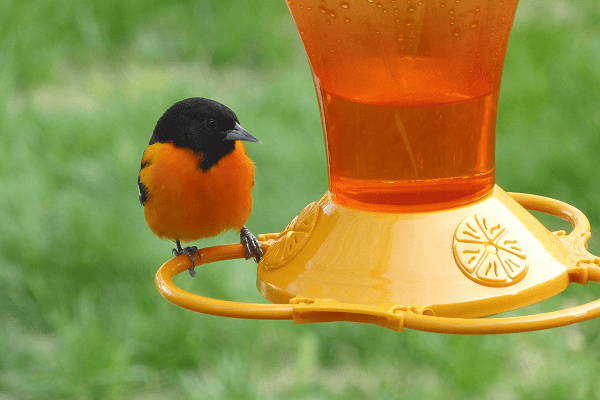
Common Oriole Species in the United States
- Baltimore Oriole: This bird is known for its bright orange and black feathers. It likes living in open woods and parks.
- Bullock’s Oriole: Found mainly in the west, it looks a lot like the Baltimore oriole but has some different markings.
- Orchard Oriole: This oriole is smaller and has a yellow and black look. It likes living near orchards and fields.
- Hooded Oriole: Common in the southwest, it builds its nest in palm trees and tall plants.
- Scott’s Oriole: Living in dry areas, this oriole stands out with its bright yellow body and black wings.
Regional Preferences for Habitat
All orioles like tall trees and thickets for shelter and food. The Baltimore oriole is often seen in cities and parks because of the flowers. But, the Bullock’s oriole prefers the west and likes open areas by rivers.
Knowing where these birds live can make bird watching more fun. It helps you see them in their natural places.
| Oriole Species | Coloration | Preferred Habitat |
|---|---|---|
| Baltimore Oriole | Bright orange and black | Open woodlands, parks |
| Bullock’s Oriole | Orange and black | Western open areas, riparian zones |
| Orchard Oriole | Yellow and black | Orchards, fields |
| Hooded Oriole | Golden yellow and black | Palm trees, southwestern regions |
| Scott’s Oriole | Bright yellow and black | Arid regions, desert areas |
Identifying the Needs of Orioles
It’s important to know what orioles need for food, water, and places to nest. This helps make your yard a welcoming spot for these lovely birds. By meeting their needs, you can make sure they come back often.
Food Requirements for Orioles
Orioles eat a mix of foods. They love:
- Nectar from flowers and feeders
- Fresh fruits like oranges, apples, and berries
- Jelly, especially grape jelly, which many orioles adore
Avoid sugar-free foods as they can be bad for orioles. Good food will draw more of these colorful birds.
Water and Bathing Preferences
Clean water is key for orioles. They need it for drinking and bathing. Knowing what they like can help you set up your yard right:
- Shallow basins or birdbaths they can easily use
- Motion features, like moving water, to grab their attention
Keep the water fresh by cleaning it often. This makes it more inviting for the birds.
Safe Shelter and Nesting Areas
Safe places to nest are crucial for orioles. They like areas with lots of leaves for hiding from predators. Think about:
- Planting trees and big shrubs that offer good cover
- Creating a mix of open and hidden spots
By making a safe place, you’ll encourage orioles to nest in your yard.
How to Attract Orioles
To attract orioles, start by knowing what they like to eat. They love sweet foods like sugar water and fresh fruits. Making your yard welcoming with these foods can bring them to your yard.
Choosing the Right Food for Orioles
Orioles prefer certain foods that can help you attract them. They love a sugar-water mix, or homemade nectar. Mix six parts of water with one part of white sugar. Don’t add any extra stuff. Fresh orange halves are also great for drawing them in.
Essential Ingredients for Homemade Nectar
To make the best homemade nectar, follow these steps. You’ll need:
- 6 cups water
- 1 cup white granulated sugar
Mix these in a saucepan and stir until the sugar is gone. Let it cool before filling your feeders. Put out your feeders early in spring to welcome orioles.
| Food Type | Benefits |
|---|---|
| Sugar Water | Provides energy; essential for their feeding habits |
| Fresh Fruits | High in vitamins; helps with hydration |
| Jelly | Rich in sugars; encourages orioles to visit frequently |
With the right food and setup, your yard can be a great place for orioles.
Providing Fresh Food: Best Food Options for Orioles
To make your yard welcoming for orioles, offer a mix of fresh foods. Use different feeders to attract these colorful birds. Knowing what fruits orioles like is key to getting them to visit often.
Best Fruits to Offer
Orioles love some fruits more than others. Here are the top picks:
- Oranges: These citrus fruits are a hit with orioles, drawing them in with their bright color.
- Peaches: Soft and juicy, peaches are a treat that orioles can’t get enough of.
- Apples: Sliced apples are easy for orioles to eat, making them a great snack option.
- Berries: A mix of blackberries, blueberries, and raspberries is a tasty and healthy choice for orioles.
The Role of Jelly and Nectar Feeders
Oriole jelly feeders are a must for these birds. They offer a tasty treat that can bring more birds to your yard. Make sure feeders are easy to see and reach. Clean and refill them often to keep the food fresh.
Using fruits and jelly together makes a great diet for orioles. Keep the food fresh to attract these beautiful birds to your yard.
Setting Up Your Yard: Attracting Orioles with Feeders
To make your yard welcoming for orioles, pick the right feeders and place them well. Knowing the best feeders helps these colorful birds feel at home. Using smart feeder placement tips can really help attract orioles.
Types of Feeders Ideal for Orioles
It’s key to choose the right oriole feeders to draw these lovely birds. Great feeders have:
- Large perches for orioles’ posture.
- Deep wells for lots of nectar.
- Strong materials that last through weather.
- Bright colors to catch orioles’ eyes.
Feeders made just for orioles are best. They match the birds’ eating habits, making it easier to get them to visit your yard.
Placement Tips for Maximum Visibility
After picking the right oriole feeders, place them well to make them easy to see. Here are some tips:
- Put feeders near trees or flowers that orioles like.
- Keep them away from busy spots that scare birds.
- Make sure they’re easy to see from afar.
- Move feeders around to find the best spots.
Using these tips makes your yard a cozy spot for orioles. This means you’re more likely to see them.
Water Sources: Keeping Orioles Hydrated
It’s key to have enough water for orioles to come to your yard. A great oriole birdbath meets their drinking and bathing needs. With the right bird bath features, you can make your yard a welcoming spot for them.
Features of an Ideal Birdbath
An ideal oriole birdbath has certain traits to draw these birds in:
- Shallow Design: A 2 to 3 inch depth is safe and lets orioles bathe easily.
- Easy to Clean: Keeping it clean helps prevent algae and keeps the water healthy.
- Stable Base: A strong base stops the bath from tipping over.
- Textured Surface: A bit of roughness helps orioles get a good grip.
Enhancing Water Sources with Motion
Adding motion to your oriole water sources makes them more appealing. Here are some ideas:
- Drippers: Small water drips make the bath more noticeable to orioles.
- Bubblers: Bubbling water sounds like a stream, drawing birds in.
- Solar Fountains: Solar-powered fountains keep water moving, making it more lively.
With these features and moving water, you’ll make your garden a hit with orioles. It’s good for the birds and makes your garden more lively.
Creating a Suitable Habitat: Vegetation Choices
To make your yard inviting for orioles, pick the right plants. Using native plants helps create a natural and lasting home for these birds. The right mix of trees, shrubs, and flowers can make your yard a hit with birds.
Planting Native Trees and Shrubs
Choose trees and shrubs that are native to your area. These plants offer shelter and food for orioles. Here are some top picks:
- Serviceberry (Amelanchier spp.)
- Hackberry (Celtis occidentalis)
- Black Cherry (Prunus serotina)
- Red Maple (Acer rubrum)
These plants provide food and places for orioles to nest, making your yard a perfect spot for them.
Incorporating Flowering Plants for Food
Adding flowering plants to your yard brings more insects, which orioles need for protein. Here are some plants that are pretty and feed the birds:
- Bee Balm (Monarda spp.)
- Milkweed (Asclepias spp.)
- Goldenrod (Solidago spp.)
- Columbine (Aquilegia spp.)
By picking the right plants, you can make a great home for orioles that meets their needs.
| Plant Type | Benefits | Time of Bloom |
|---|---|---|
| Serviceberry | Fruits for birds, attractive flower clusters | Spring |
| Bee Balm | Attracts pollinators, vibrant colors | Summer |
| Milkweed | Supports butterflies, food for orioles | Summer |
| Goldenrod | Late summer blooms, pollen for insects | Fall |
Seasonal Timing for Attracting Orioles
Knowing when orioles come to your yard is key. Get your feeders ready early for their arrival. This way, you’ll attract them with a good feeding schedule.
Importance of Early Preparation
Start getting ready by mid-March. This is when orioles start moving back from their winter spots. With feeders filled and ready, you’ll draw these colorful birds in.
When to Keep Feeders Available
Don’t stop feeding in the summer or early fall. Late birds might still be around, especially where food is plentiful. Keep your feeders out until at least mid-November to catch any stragglers.
| Timing | Action |
|---|---|
| March – Mid | Prepare feeders and fill with appropriate food |
| April | Monitor arrival of orioles |
| May to August | Keep feeders filled and clean for consistent feeding |
| September to October | Continue feeding; expect late migrants |
| Mid-November | Decision time for removing feeders |
Follow this feeding schedule to make your yard a welcoming place for orioles. It supports their diet and builds a strong bond with these birds. Enjoy the bright colors and sounds they add to your yard!
Encouraging Nesting: Making Your Yard a Home
It’s not just about food and water for orioles. Making your backyard a place they can nest is key. By offering the right nesting trees and materials, you’ll make it a perfect spot for them.
Providing Nesting Materials
Orioles build complex nests with various materials. You can help by giving them things like:
- Yarn and String: Bright, colorful yarn or cotton string can catch their attention.
- Animal Hair: Collecting hair from your pets can serve as soft lining for their nests.
- Plant Fibers: Natural fibers, like coconut coir, are perfect for sturdy nest construction.
- Dry Grass and Leaves: Offer dried materials that mimic their typical nesting environment.
Selecting the Right Types of Trees for Nesting
Choosing the right trees is key for orioles. Pick trees that keep nests safe from ground predators. Some great choices are:
- Cottonwoods: Their dense foliage offers protection while facilitating a nesting spot.
- Oaks: Strong branches provide stability, making them ideal for oriole nests.
- Willows: Their swaying branches mimic the orioles’ natural habitats and attract them.
- Maples: Versatile and common in backyards, these trees can easily accommodate oriole nesting.
Adding these elements to your backyard will attract orioles and make them want to come back. A welcoming space with the right materials and trees creates a great home for these lovely birds.
Monitoring and Maintaining Your Oriole Setup
Getting orioles to visit your yard is just the start. Keeping your oriole setup care up is key. Clean your feeders and baths often to keep them safe and welcoming for the birds. A regular cleaning schedule helps stop diseases and keeps the area healthy.
Regular Cleaning of Feeders and Baths
Keeping your oriole feeders and baths clean is important. Here’s how to do it:
- Remove any leftover food or debris from feeders.
- Use mild soap and warm water to scrub all surfaces, ensuring no residue remains.
- Rinse thoroughly with clean water to eliminate soap traces.
- For birdbaths, change the water often to keep it clean.
- Consider using a diluted vinegar solution for disinfecting, especially during hot months.
Adapting to Seasonal Changes
Seasons change, and so do orioles’ needs. Adjust your setup to help them:
- In spring, offer more fruit and nectar as migratory orioles return hungry.
- During summer, ensure plenty of fresh nectar and fruit daily as birds need more energy.
- In the fall, prepare for their migration by reducing food sources slowly.
- In winter, if you live in warmer climates, keep feeders clean and full to attract winter birds.
By following these steps, your yard will be a great place for orioles all year. Enjoy watching these birds while keeping them safe and healthy!
Check Our Previous Articles:
| Common Woodpigeon (Columba palumbus) |
| Woodpeckers in Montana |
| Hawks in Wisconsin |
| Backyard Birds of Hawaii |
Conclusion
In this recap, we looked at how to make your yard a home for orioles. We talked about offering fresh foods, keeping water clean, and adding the right plants. These steps make your yard a place orioles love to visit.
Remember, it might take time for orioles to find your yard. But with regular effort, you’ll have a better chance of seeing them.
By doing these things, you help orioles and make your yard more enjoyable. So, enjoy watching birds and keep your feeders full. Keep an eye out for these beautiful birds!

